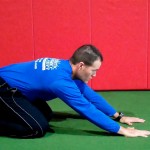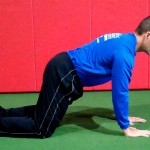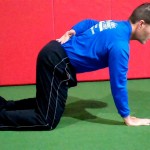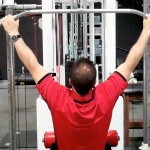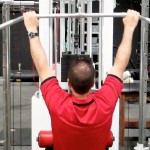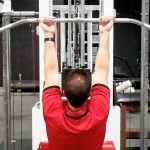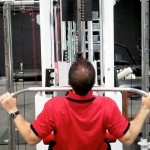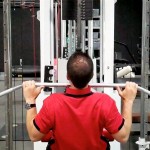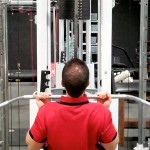Brian Schiff’s Blog
Injury Prevention, Sports Rehab & Performance Training Expert
I work with several overhead athletes ranging from swimmers and tennis players to professional baseball pitchers. One consistent issue I see is tightness in the anterior chest wall coupled with poor scapular activation and stability. For that reason, I often turn to snow angel exercises. I wanted to share two variations I have written on before. The first version utilizes a foam roller. The movement is performed throughout a full arc of movement upward and downward.

Top position

Bottom position
Click here for more details on the execution of this exercise
This is an excellent exercise that can be integrated as part of a warm-up/movement prep session as well as used in recovery and the cool-down to address soft tissue tightness in the chest, facilitate proper posture and encourage scapular retraction and depression.
I often use this exercise in combination with pec minor myofascial release and thoracic spine extension mobilization on the roller. It is a staple in all of my rehab and prehab programs with all of my overhead athletes.
The second version involves moving to an upright position and can prove more challenging. The exercise is also designed to promote scapular stability. When done properly, the client will demonstrate proper upward rotation (avoid tipping and winging of the scapula) on the ascent, and then emphasize recruitment of the rhomboids and lower trap to achieve proper downward rotation on the descent.
It can be a very fatiguing activity and somewhat frustrating for clients when starting out. Be sure to cue them accordingly, and let them know it may not be easy to keep full contact. It may also be necessary to utilize soft tissue mobilization for the pecs/lats as well as stretching beforehand to promote a more normal movement pattern.

Top position

Mid position

Bottom position
In this anti-gravity version fatigue becomes more of an issue, so emphasizing quality movement and using less repetitions may be indicated. Do not push through any painful motion.
Click here for more details on the execution of this exercise
I always look for exercises that allow me to actively elongate traditionally short muscles while encouraging proper muscle activation of weak/poorly recruited muscles. This exercise does just that. If you are interested in the impact of pec minor tightness and shoulder impingement, check out the article from JOSPT below:
For those familiar with my blog, you know I like to post research updates and exercises that prevent injury and maximize performance. In my setting, I get to work with a very active population ranging in ages from 10-50 in most cases, including elite and professional athletes. I am pointing this out simply because I have an opportunity to test and measure unique and challenging exercises every day with fit, athletic clients.
As part of my world, I am often faced with restoring shoulder, core and hip stability. As clients progress through rehab and conditioning, I am always seeking advanced training options that are feasible and functional. One training tool I like to employ, especially in upper body, core and hip training is the BOSU Balance Trainer.
Emphasizing co-contraction and scapulothoracic and glenohumeral stability is essential for optimal shoulder function. But more importantly, addressing kinetic chain function in the shoulder, torso and hips is a must if we are to soundly address energy leaks and reduce injury risk. To that end, I like to incorporate unstable closed kinetic chain training when my athletes are ready. The video below demonstrates two upper body step-up progressions (forward and side-to-side) on the BOSU Balance Trainer that I utilize for higher level clientele.
Upper Body Step-ups
Regression – in place stepping (this can be used to prepare clients for the step-ups)
This regression can also be a very effective training tool especially if the client lacks sufficient strength, endurance and form to execute the full step-up patterns. Pain and form should always guide exercise selection and progression.
Below are two links to my Functionally Fit columns describing the execution and application of these exercises:
Below are two videos demonstrating some sliding exercises I like to use in training and rehab. The first video reveals one of my tougher hamstring exercises I prescribe, while the second video displays some shoulder/core stability variations using sliding discs. I have included links to the PFP columns that better explain the set-up, execution and application for each exercise.
Click here for the Functionally Fit Column on sliding hamstring curls.
Click here for the Functionally Fit column on sliding shoulder raises.
Research along with years of observation has taught me that the brain is inherently looking for the most efficient way (aka least effort) to execute movement in life. In addition, it HATES pain just like you and I so it does everything possible to avoid it including ordering the body to perform dysfunctional movement patterns.
After a painful episode, the brain often needs reminded that the body can go back to the proper movement patterns once the pain is gone. However, it often holds that painful memory and may by default lean toward a faulty movement pattern. This protective mode then ends up perpetuating a faulty movement pattern that is no longer necessary nor efficient. Over time, dysfunctional movement patterns can create further stress or harm to other segments in the kinetic chain.
So, I am always seeking ways to stimulate the body to work properly and exercises that facilitate proper neuromuscular patterning are instrumental in my rehab and training. I wanted to share two exercises that I like to utilize in my rehab and training for the shoulder. In particular, I like to employ closed chain activity to stimulate the serratus anterior as well as the other scapular stabilizers.
Below are two exercises I wrote about in my “Functionally Fit” column for PFP magazine. The first exercise shows quadruped rocking. Shirley Sahrmann mentions this in her work, Diagnosis and Treatment of Movement Impairment Syndromes. I began using it after reading her book, and I agree that it works very well for scapular dysfunction. Below is the start and finish position for the quadruped version as well as my own advanced tripod version of the exercise.
- Quadruped start
- Quadruped finish
- Tripod finish
For a complete explanation of the exercise and its application, click here to read the column.
As a follow-up to this exercise, I included an unstable progression I like to employ using the BOSU trainer. I call this the unstable tripod scapular clock. It can be done on the knees or up on the toes. I have included a quick video on this below. Again, I like this exercise for scapular work as well as core stability training.
Click here to read my PFP column on this exercise for the full description, application and regressions. The real beauty of this last exercise is the “big bang for your buck” attributes since it hits shoulder, core and hip stability all at once for those able to work at that level. I hope it works as well for you as it has for me!
One of the most common issues I see in the clinic with active exercise enthusiasts between the age of 20 and 55 is shoulder pain. Weightlifting has been popular for ages, but Crossfit is all the rage these days. Both disciplines involve overhead lifts. The key thing to remember when performing overhead repetitive lifts is how load and stress not only affects strength and power, but how it impacts the joint itself.
Pull-ups and pull-downs are staples for most clients I see. As a therapist and strength coach, I am always thinking and analyzing how variables such as grip, grip width, arm position, scapular activation, trunk angles etc influence exercise and how force is absorbed by the body. One such exercise I have spent time studying and tweaking is the lat pull-down.
Consider for a moment how width and grip impacts the relative abduction and horizontal external rotation in the shoulder at the top and bottom of the movement in the pictures below (start and finish positions are vertically oriented):
It should be common knowledge for most, but I will state it for the record anyway – you should NEVER do behind the neck pull-downs. Beyond the horrible neck position, this places the shoulder in a dangerous position for impingement and excessively stresses the anterior shoulder capsule. A wider grip (be it with pull-ups, pull downs, push-ups) will always transfer more stress to the shoulder joint because you have a longer lever and greater abduction and horizontal external rotation.
So, what bearing does this have in relation to the rotator cuff and SLAP injuries? For more information and details on the application of the grip choice, click here to read the full column I did for PFP Magazine this month. Stay tuned for my next post (a follow-up to this one) one of my Crossfit patients who now only has pain with overhead squats and how my differential diagnosis and rehab has led me to conclude what is wrong with his shoulder. Keep in mind we must learn to train smarter so we can train harder and longer without pain and injury. Biomechanics and understanding your own body really does matter.

